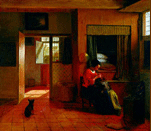










4.
Framing the Domestic
in Early Modern England:
Private Spaces/Public Matters
Organizers:
Description:
The politics of seventeenth and early eighteenth-century England were, regardless
of who was in power, most often constructed in the gendered terms of the private.
From James I’s justification of absolute rule through the metaphor of
the body politick in Basilikon Doron to Milton’s Eikonoklastes
which posits Charles I as too uxorious, too dependent on his French, Catholic
queen Henrietta Maria, male and female writers and artists saw the politics
of the state as thoroughly steeped in the politics of the personal. Inevitably,
the politics of the hotly contested public sphere depended on a delicate negotiation
and construction of an “appropriate” private sphere, one that
was delineated in gendered terms of the feminine since it was women (in their
roles as wives, mothers, and daughters) who were most closely aligned with
the domestic, private and interior space of the early modern household.
We will spend the first 15-20 minutes of the workshop examining the ways in
which political instability translated into domestic uncertainty in both visual
and literary texts of the period, such as Ben Jonson’s Masque of Queens,
Van Dyck’s portraiture of Charles I and Henrietta Maria, Margaret Cavendish’s
Sociable Letters, John Milton’s Eikonoklastes and Eikon Basilike, and
Daniel Defoe’s The Family Instructor. We will discuss how these several
texts provide varying representations of women’s domesticity and their
complex, dynamic relationship with the larger public and political spheres.
After our initial presentation, we will have the participants form small groups
and, for the next 50 minutes, we will workshop excerpts from these texts that
specifically foreground women’s roles in fashioning a politics of domesticity.
For the last 20 minutes, all the groups will reconvene and discuss their findings.
Some of the questions we hope to explore are as follows. How does women’s
writing redefine the domestic sphere while shaping an emergent public one?
How do seemingly more gendered forms of women’s writings—letters,
for example—reveal the female author’s complex negotiation of
the public and political spheres? How do court performances stage a struggle
for the control of the representation and categorization of women’s
public and private lives? How do royalists in visual and printed texts deploy
the family to bolster monarchical power? How do oppositional voices use the
family/state analogy to argue for contractual and republican forms of government?
Readings:
|
|
|
||||||
|
|
 |
 |
|
||||
 |
|
 |
|
||||
|
|
|
||||||
|
|
|
||||||
 |
|
||||||
|
|
|
||||||
| |
|
||||||
 |
|
||||||
 |
|
||||||
 |
|
||||||
 |
|
||||||
|
|
|
||||||
|
|
 |
|
|
||||
 |
|
||||||
|
|
|
|
|
|
|
|
|